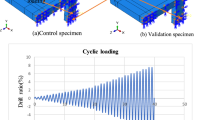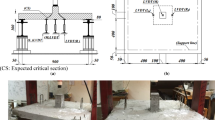Abstract
Slab–Column connection is one of the critical structural joints in building construction, since there are special design requirements that must be achieved. This paper investigates RC slab–column connections under eccentric load using a built-in 3-Dimensional Nonlinear program of finite element in the pre- and post-cracking levels and up to the ultimate load. The concrete is simulated as isoparametric brick element, and the reinforcement bar elements are assumed to be built into isoparametric brick elements. With regard to load–deflection responses and ultimate strength capacity, a good coincidence is achieved for FEA and experimental results with maximum difference 1.6% for ultimate strength. In addition, the structural performance investigation of slab–column connection is carried in terms of the effectiveness of applied load types, shear reinforcement and slab thickness. It can be concluded that the increase in loading eccentricity cause decreasing in ultimate load 20.5 to 40% in comparison with case of e = 0, which is one of conclusion of this research. Also, the use of shear reinforcement (48 stirrups of Φ10 mm) in the flat slab connection with columns had more effects than slab depth. It is found that the ultimate load capacity increases about 34.4% with e = 0.0, while it decreases about 22% with e = 0.45 m when compared with slab–column connections without shear reinforcement (e = 0.0). In addition, as the slab thickness increases from 150 to 200 mm, the ultimate load increases about (25%) when compared with case of (e = 0.0), while the ultimate load increases about (2.3%) when compared with the same case of (e = 0.0), which means that the increment in the slab thickness can be considered as compensation for the effects of increasing in load eccentricity. Also, for the slab–column connection without shear reinforcement, the related formula of ACI-code gives a good agreement in terms of ultimate load capacity in comparison with the results of adopted FE model with maximum difference 4% as the unbalanced moment was increased, while for usage of shear reinforcement in slab–column connection, the formula of ACI-code becomes more conservative with maximum difference 10% with increasing of unbalanced moment.














Similar content being viewed by others
References
AL-Nafakh HM (2004) Three-dimensional nonlinear finite element analysis of fibrous prestressed concrete beam under torsion. M.Sc. Thesis. University of Kufa, Kufa, Iraq
Al-Sharbaf IAS (1990) Three dimensional non-linear finite element analysis of reinforced concrete beams in torsion. Ph. D. thesis. University of Bradford, UK
American Concrete Institute (ACI) ACI 318-14 (2014) Building code requirements for structural concrete and commentary. ACI, Farmington Hills, MI
ASCE (2002) Task committee on finite element analysis of reinforced concrete structures. State-of-the-art report on finite element analysis of reinforced concrete. ASCE Special Publications
Chaudhari YA, Katti PGB (2016) Finite element analysis of effect of punching shear in flat slab using ansys 16. Int J Eng Sci Invent 5(4):49–54
Ferreira MP, Melo GS, Regan PE, Vollum RL (2014) Punching of reinforced concrete flat slabs with double-headed shear reinforcement. ACI Struct 111(March):340–350
Goh CYM, Hrynyk TD (2018) Numerical investigation of the punching resistance of reinforced concrete flat plates. J Struct Eng 144(10):04018166
Kheyroddin A, Hoseini Vaez SR, Naderpour H (2008) Investigation of finite element model of slab–column connections under eccentric loading. In: The 14th world conference on earthquake engineering October 12–17, Beijing, China
Krüger G, Burdet O, Favre R (2000) Punching strength of R.C. flat slabs with moment transfer. In: Int. work. Punching Shear, pp 1–8
Mabrouk RTS, Hegab AA (2017) Analysis of the punching behavior of RC flat slabs with horizontal and vertical shear reinforcement. MATEC Web Conf 120:01006. https://doi.org/10.1051/matecconf/201712001006
Mabrouk RTS, Bakr A, Abdalla H (2017) Effect of flexural and shear reinforcement on the punching behavior of reinforced concrete flat slabs. Alex Eng J 56(4):591–599
Mahmoud AM (2015) Finite element implementation of punching shear behaviors in shear-reinforced flat slabs. Ain Shams Eng J 6(3):735–754
Meisami MH, Mostofinejad D, Nakamura H (2014) Punching shear strengthening of two way flat slabs with CFRP grids. J Compos Constr 18(2):04013047
Meisami MH, Mostofinejad D, Nakamura H (2015) Strengthening of flat slabs with FRP fan for punching shear. Compos Struct 119:305–314
Nilson AH, Darwin D, Dolan ChW (2003) Design of concrete structures, 13th edn. McGraw Hill, New York
Wörle P (2014) Enhanced shear punching capacity by the use of post installed concrete screws. Eng Struct 60:41–51
Author information
Authors and Affiliations
Corresponding author
Rights and permissions
About this article
Cite this article
Al-Katib, H.A.A., Alkhudery, H.H. & Al-Katib, A.A.A. Flat Slab–Column Modeling Using Finite Element with Eccentric Loading Effects. Iran J Sci Technol Trans Civ Eng 44, 513–521 (2020). https://doi.org/10.1007/s40996-019-00249-z
Received:
Accepted:
Published:
Issue Date:
DOI: https://doi.org/10.1007/s40996-019-00249-z




